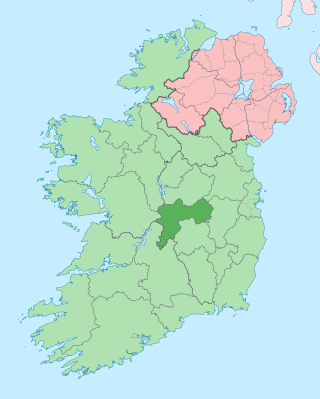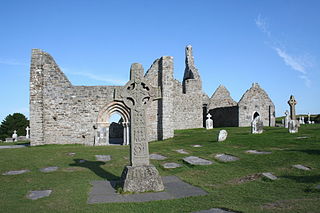
County Offaly is a county in Ireland. It is part of the Eastern and Midland Region and the province of Leinster. It is named after the ancient Kingdom of Uí Failghe. It was formerly known as King's County, in honour of Philip II of Spain. Offaly County Council is the local authority for the county. The county population was 82,668 at the 2022 census.
Bord na Móna is a semi-state company in Ireland, created in 1946 by the Turf Development Act 1946. The company began developing the peatlands of Ireland with the aim to provide economic benefit for Irish Midland communities and achieve security of energy supply for the recently formed Irish Republic. The development of peatlands involved the mechanised harvesting of peat, which took place primarily in the Midlands of Ireland.

Portarlington, historically called Cooletoodera, is a town on the border of County Laois and County Offaly, Ireland. The River Barrow forms the border. Portarlington is around 70 kilometres (43 mi) west of Dublin. The town was recorded in the 2022 census as having a population of 9,288.

Rosscarbery is a village and census town in County Cork, Ireland. The village is on a shallow estuary, which opens onto Rosscarbery Bay. Rosscarbery is in the Cork South-West constituency, which has three seats.

Ferbane is a town in County Offaly, Ireland. It is on the north bank of the River Brosna, between Birr and Athlone at the junction of the N62 and R436 roads, 20 km south of Athlone. The name of the town is said to come from the white bog cotton which grows in the surrounding Bog of Allen.

Clonmacnoise is a ruined monastery situated in County Offaly in Ireland on the River Shannon south of Athlone, founded in 544 by Saint Ciarán, a young man from Rathcroghan, County Roscommon. Until the 9th century it had close associations with the kings of Connacht.

Shannonbridge is a village located on the River Shannon, at the junction of the R444 and R357 regional roads in County Offaly, Ireland. It lies within the townland of Raghra, at the borders of counties Offaly, Galway and Roscommon, with the majority of the population living east of the bridge in County Offaly. As of the 2016 census, the village had a population of 175. There are two housing estates within the village. Its location along Ireland's largest river and its proximity to Clonmacnoise have contributed to tourism being a key contributor to the local economy. The village is flanked by a Special Area of Conservation – the Shannon Callows. The physical environment consists of the River Shannon, callows, boglands and the Esker Riada. The village has one of the oldest bridges still in use over the River Shannon, completed in 1757.

Daingean, formerly Philipstown, named after King Philip II of Spain, is a small town in east County Offaly, Ireland. It is situated midway between the towns of Tullamore and Edenderry on the R402 regional road. The town of Daingean had a population, as of the 2022 census, of 1,223. It is the principal town of the Daingean Catholic Parish. The other main poles of this parish are Ballycommon, Kilclonfert and Cappincur.

Kilcormac is a small village in County Offaly, Ireland, located on the N52 at its junction with the R437 regional road, between the towns of Tullamore and Birr. It is a small village of 935 people, many of whom were previously employed by Bord na Móna to work the local peat bogs. The village is located near the Slieve Bloom Mountains. The Silver River flows through the village. The village was more commonly referred to as Frankford prior to Irish independence.

Clonegal, officially Clonegall, is a village in the southeast of County Carlow, Ireland. It is in a rural setting, close to the border between counties Wexford and Carlow, 5 km (3 mi) from Bunclody, County Wexford and 22 km (14 mi) from Carlow town. It is just over a mile north of where the River Slaney and the River Derry meet. Clonegal has a much smaller "twin" village across the River Derry in County Wexford, Watch House Village.

Edenderry is a town in east County Offaly, Ireland. It is near the borders with Counties Kildare, Meath and Westmeath. The Grand Canal runs along the south of Edenderry, through the Bog of Allen, and there is a short spur to the town centre.

Carbury, also formerly spelt "Carbery", is a rural community and a village in north-west County Kildare, Ireland. It is situated on the R402 regional road between Enfield and Edenderry, near the border with County Offaly, and includes the smaller hamlets of Derrinturn, Ticknevin and Killina along the Grand Canal (Ireland). The source of the River Boyne is located just north of the village. The village is in a townland and civil parish of the same name.
Oldtown is a population centre and townland in the civil parish of Clonmethan in Fingal, County Dublin, Ireland. The R122 road runs through the village linking Naul to St Margaret's and Dublin Airport.

Clonaslee is a village in north County Laois, Ireland, situated in the foothills of the Slieve Bloom Mountains on the R422 Mountmellick to Birr road. Clonaslee is approximately 100 km west of Dublin, and is close to the towns of Portlaoise and Tullamore.
Deansgrange is a southern suburb of Dublin, centred on the crossroads of Clonkeen Road and Kill Lane. The area shares the name Clonkeen with the area further east, known as Kill of the Grange.

Walsh Island or Walshisland is a village in County Offaly, Ireland. It takes its name from the surrounding hinterland which is a fertile area of land on a hill (104m) located in an area of bogland known as the Bog of Allen,. The village is one kilometre west of the R400 regional road which runs through the bog below. Walsh Island is 12 km from the nearest town, Portarlington. As of the 2016 census, the village had a population of 443 people.

Clonony is a small village in County Offaly, Ireland. It is noted for Clonony Castle, a late medieval tower house built in 1500. The village is between the River Brosna and the Grand Canal, in the parish of Gallen and Reynegh. The nearest town is Cloghan, 2.8 km (1.7 mi) to the south-east along the R357 road. Athlone is 22 km (14 mi) to the north.

Rhode is a village in County Offaly, Ireland. It is situated on the R400 at its junction with the R441 which leads to Edenderry, 12 km to the east. Rhode village is on an "island" of high ground surrounded by an expanse of raised bog which forms part of the Bog of Allen.
Clonbullogue Airfield is a small Irish airfield located about 2 km (1.2 mi) west of Clonbullogue and 6 NM south of Edenderry in County Offaly, Ireland. It is owned and operated by the Irish Parachute Club which is based at the field. The airfield has one grass runway running east–west which is 770 by 18 m. Six aircraft are based at the field, most of them owned by the Irish Parachute Club. There is usually busy parachuting at weekends and public holidays so flying restrictions are enforced around this area.
The Irish Parachute Club (IPC) is an air sports club, located in Clonbullogue, County Offaly, in Ireland.



















